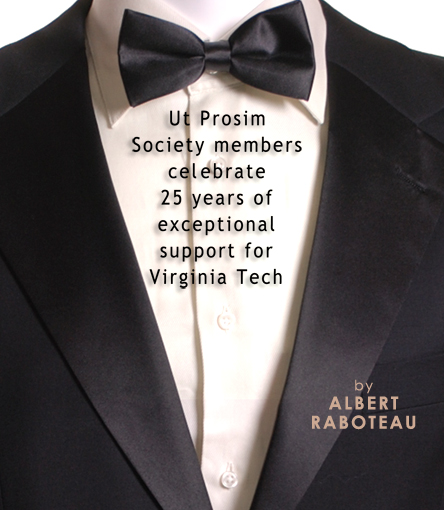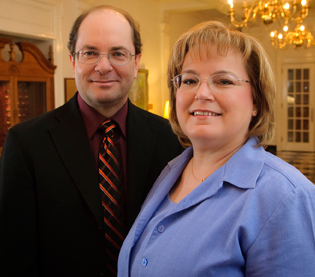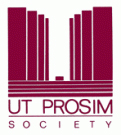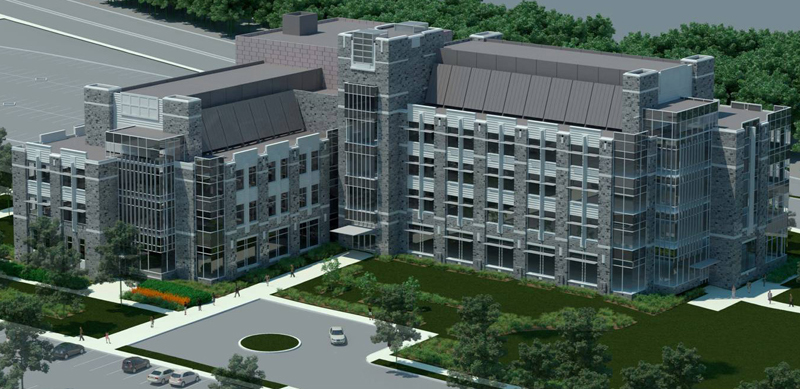
|
|
|
|
|
|

|
|
|
|
Go HERE to view a video highlighting the Ut Prosim Society's 25 years of growth at Virginia Tech.
|
|
|
Like many passionate Virginia Tech football fans, Doug and Nina Trott traveled to Blacksburg, Va., the last weekend in April this year.
But this time it was not just the Hokies' spring game that drew them back to their alma mater. The Trotts came to be inducted into the Ut Prosim Society, a select group of the university's most generous donors.
The Trotts--who run Capital Pension Services Inc. in their hometown of Woodbridge, Va.--are two of the more than 100 people who joined the society this year.
They and other new members were honored at a gathering at the Inn at Virginia Tech and Skelton Conference Center that also included a celebration of the group's 25th year.
Nina Trott (management '78) says Virginia Tech "just felt like home" from the first time she visited campus. She met her husband, Doug (finance '78), while in college. Their two sons are alumni. Each of the Trotts also has a sibling who graduated from the university.
Given those family ties, the Trotts say it's natural to want to donate and help the university continue to excel. But that's not the only reason they give, Nina Trott says.
|
|
|
|
|
|
|
"There are very few places where you can put your money where you know it will be handled well," she says. "We have faith in the leadership of Virginia Tech that they will use our gifts in the best way that advances the university's goals."
Like many members of the Ut Prosim Society, the Trotts have supported a wide range of programs. In their case, that includes the business college they attended; the College of Liberal Arts and Human Sciences that educated their sons; the Department of Athletics; and the Virginia Center for Civil War Studies, headed by James I. Robertson, the university's famous Civil War historian.
"We both took Dr. Robertson's class [on the Civil War], and anyone who's ever been in that class will tell you it's great," Doug Trott says.
THANKING THOSE WHO GIVE
The Ut Prosim Society was established in 1986 as a way to recognize exceptionally generous supporters like the Trotts. Donors and their spouses are invited to join after reaching $100,000 in lifetime giving to the university. Within the society, membership levels honor those who reach $250,000, $500,000, and $1 million in contributions.
|
|
|
|
|
|
 |
|
Doug '78 and Nina '78 Trott
|
|
|
|
|
| The society began with 230 members and today has 1,907. Including members who have passed away, 2,238 people have belonged to the society. As a whole, society members have given or pledged nearly $1.5 billion to Virginia Tech.
In recent years, Ut Prosim Society members have played a pivotal role in The Campaign for Virginia Tech: Invent the Future. Including pledges, members contributed nearly $375.5 million between the beginning of the campaign in July 2003 and the end of March this year--more than 41 percent of the total raised during that period.
ENCOURAGING OTHERS TO GIVE
In addition to generous financial support, many Ut Prosim Society members, including the Trotts, give their time. While volunteering on campaign committees, they encourage other alumni and friends to support the campaign, a vital part of the fundraising effort.
Nina Trott says she and her husband have been happy to serve on the campaign committee focused on the Northern Virginia region because "in a time when state funds are being cut, we feel it is especially important to step up and support the university."
|
|
|
|
|
|
|
|
|
|
|
Jane '85 and Hance '86 West
|
|
|
|
|
|
Hance West (accounting '86) was working at an investment firm in the 1990s when a colleague and fellow Hokie encouraged him to donate to Virginia Tech. Today, West, a managing director with Investure LLC in Charlottesville, Va., serves on a campaign committee for the Richmond, Va., region.
"It's an opportunity to reach out to other Hokies who share our commitment to the university and who can help advance the mission of Virginia Tech," West says.
Like the Trotts, West and his wife, Jane (finance '85), are new members of the Ut Prosim Society. Along with supporting athletics, the Wests, who live in Glen Allen, Va., created a fund to benefit BASIS, a student investment team that focuses on bonds.
25 YEARS OF PROGRESS
Each year, the induction of new members like the Trotts and the Wests into the Ut Prosim Society illustrates how a remarkably strong tradition of giving back to Virginia Tech has carried on for generations.
T. Marshall Hahn Jr. was in his second year as president of the university when West was born, and Hahn was an original member of the Ut Prosim Society in 1986. Hahn, whose daughter and grandson became society members last year, says he is not surprised that the society has grown nearly 830 percent in 25 years.
"But I am impressed by it, and I applaud it," adds Hahn, who led the university from 1962 to 1974 and still lives in Blacksburg. "The university has grown and strengthened, and the enthusiasm of the alumni has grown and strengthened. I think that it's to be expected that there would be this magnificent, cumulative level of support."
 For more information on Virginia Tech's giving societies, visit www.campaign.vt.edu/society. For more information on Virginia Tech's giving societies, visit www.campaign.vt.edu/society.
ALBERT RABOTEAU is a writer for University Development.
|
|
|
|
|
|
|
|
|
|
Ut Prosim Society: 25 Years of Progress
|
|
|
|
|
|
|
A signature facility for an exemplary college
|
|
by ALBERT RABOTEAU
|
|

|
|
Zimmer Gunsul Frasca Architects' design for the Signature Engineering Building echoes the neo-Gothic look familiar on campus but also has many contemporary touches, including large amounts of glass to allow for natural light.
 Visit www.eng.vt.edu/signaturebuilding for additional renderings of the new building. Visit www.eng.vt.edu/signaturebuilding for additional renderings of the new building.
|
|
|
|
|
| A dramatic new building earmarked for the northern end of campus will showcase one of the nation's premier engineering programs and provide much-needed space for its students and faculty.
"The Signature Engineering Building will be a world-class instructional facility that will attract the nation's brightest students and faculty," says John Sparks (mechanical engineering '74, M.S. '76, Ph.D. '81), an Aerojet executive who has been a vocal advocate in Richmond for the project and is the incoming vice-chair of the College of Engineering Advisory Board.
Located near the corner of Prices Fork Road and Stanger Street, the four-story building will address the space crunch faced by a growing college, says Richard Benson, the college's dean.
"We have a much larger faculty than we did in the 1990s, we have a lot more students, and we have an urgent need for this kind of space," Benson says. "We're the nation's third-largest producer of undergraduate engineers after Georgia Tech and Penn State."
Students and faculty will both benefit from the new building. It will contain seven general-assignment classrooms and a 300-seat auditorium. The building also will house the chemical engineering department, engineering education department, and part of the mechanical engineering department.
The departments of mechanical engineering and aerospace engineering also will have showcase laboratories on the ground floor. One memorable feature of the building is a dramatic glass atrium that will contain a turbine engine.
Another notable feature is a glass-enclosed space on the third floor that will be visible from the atrium and will house the Virginia Tech Engineering Communication Center, co-directed by Assistant Professors of Engineering Education Lisa McNair and Marie Paretti.
"We really like the open design of the building," says McNair, whose department is currently located in McBryde Hall, separate from other engineering programs. "Being integrated with other engineering departments will allow more opportunity for collaboration between our department and the rest of the college."
State support will play a key role in the university's plan for this much-needed new building for the College of Engineering, but ultimately, the success of the project will depend on private money.
Officials are working to raise $50 million in contributions to help fund the 153,000-square-foot building. Dozens of supporters have already contributed generously, but significant private funding is still necessary. On the state's side, the project is included in a $1 billion capital program approved by the 2010 General Assembly.
College of Engineering Associate Dean and Chief of Staff Ed Nelson, who is overseeing much of the project for the college, says the goal is not just to provide much-needed space, but to inspire future engineers as well.
"We want to make Virginia Tech and the College of Engineering an inspiring place to work and study, and this building is part of that."
ALBERT RABOTEAU is a writer for University Development.
|
|
|



